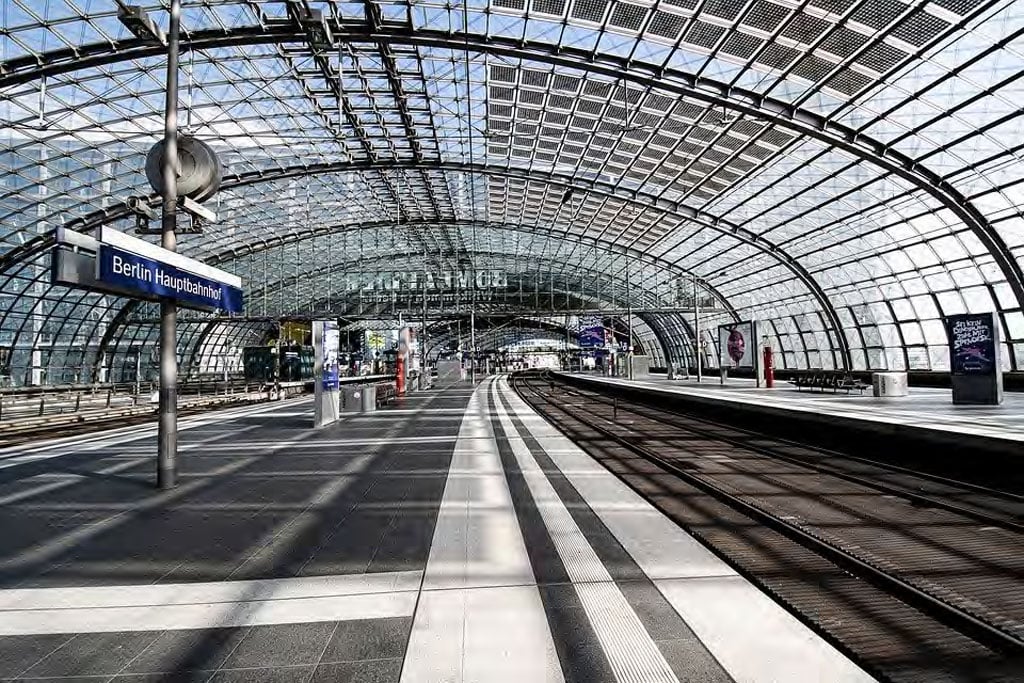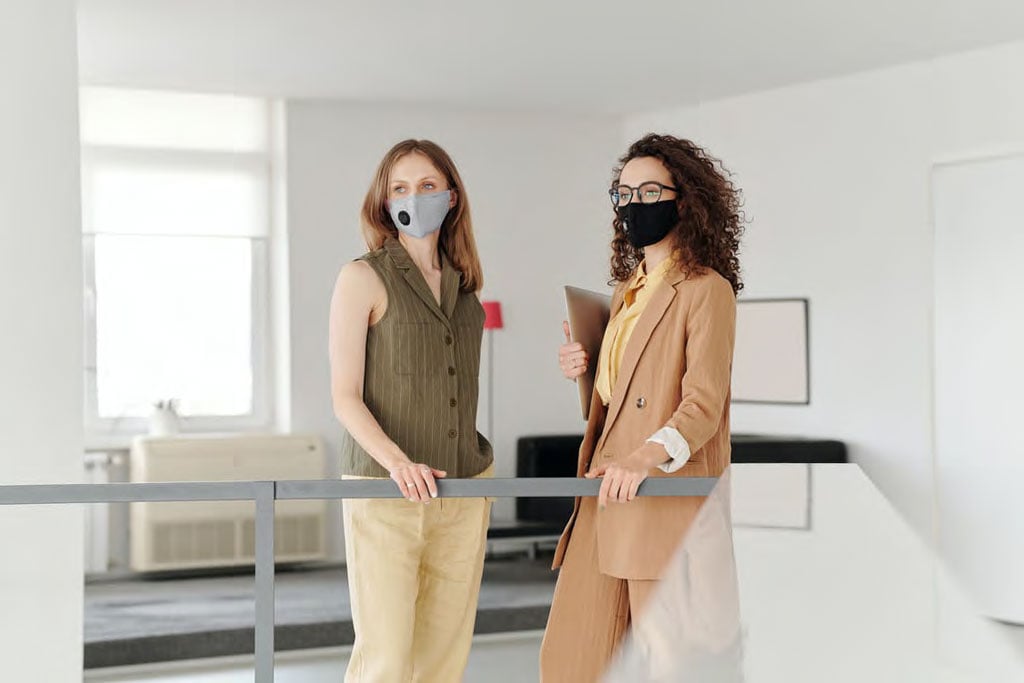Design and innovation are the driving forces behind architecture. With COVID-19 reshaping what we define as ‘normal’, the field of architecture seeks to address the various challenges put forth by the pandemic. While the duration of this current pandemic is unknown, it is a good time to anticipate possible architectural developments in the future and learn how to react to them. In this article, we will look at possible architectural changes happening in the post-COVID world.
1. Public space
 Berlin Hauptbahnhof railway station during the city's lockdown.
Berlin Hauptbahnhof railway station during the city's lockdown.
Among the many things that will not be the same in the post-COVID-19 world are the spaces we live, work, socialise, shop, study and seeking healthcare. Many visible additions and modifications are already taking place—for example, temperature checking stations at building entrances with social distance markers. More long-term and permanent changes will have to be made, including the use of construction and interior design materials which are bacteria/virus resistant. While working from home is here to stay in some form, one cannot doubt that there will still be a need to provide those cultural bonds that inspire and motivate people in a physical workspace.
The pandemic has taught us that while popular public spaces have always been the most engaging and the most crowded, sharing can also be possible under strict social distancing measures. As these norms of personal space evolve, public spaces become more flexible in terms of physical engagement. Future architecture projects are already looking into dispersing people in more expansive areas and are generating different and parallel journeys.
2. Office space
 Mask wearing in offices will become a new norm for a while.
Mask wearing in offices will become a new norm for a while.The COVID-19 pandemic continues to disrupt the future of office design from raising questions about shared offices, to open office designs. Increased telecommuting and new means of online interaction have also contributed to the disruption.
It is unthinkable that the post-COVID architecture world is not rethinking architecture, construction, furniture placement and design, alongside greater integration of technology. How should office space adapt to the current environment and the changes still to come?
Co-working spaces are similarly threatened. Fueled by the rise in self-employment and individuals’ desire to connect to a broader community, co-working environments had grown dramatically in recent years. WeWork, for example, was the largest tenant in Manhattan with nearly 9 million square feet of real estate as of April. However, even after stay-at-home rules are lifted, workers are unlikely to return in the same numbers for fear of contagion.
So is commercial office space no longer relevant? The decelerating trends carry significant financial, social, and psychological impact. A mass exodus from the real estate market would result in a severe recession—or worse. Furthermore, any presumption that working from home is the new normal disregards the challenges such an arrangement poses to many residence-bound employees, including the sense of alienation and loss of community, the lack of access to particular tools or resources, and—in the case of families—the distractions arising from multiple individuals under the same roof.
3. Usage of Internet of Things (IoT)
 Thermal scanning before entering buildings.
Thermal scanning before entering buildings.An increase in the usage of Internet of Things(LoT) has a significant impact on the world and plays an integral part during the COVID-19 pandemic.
COVID-19 has made us more sensitive to a countless number of truths. What lives on the surfaces we touch, how can we monitor and maintain our physical assets without humans, and how do we ensure the health and safety of those who live or work in buildings. A digital transformation post-COVID is almost inevitable while we incorporate contactless connectivity in our business strategy to enable community and building residents to feel safer.
Most people predict that public spaces will move toward more automation and high technology, with COVID-19 speeding up the development of all types of contactless technology. Examples include automatic doors, voice-activated elevators, mobile phone-controlled hotel room entry, hands-free light switches and temperature controls, automated luggage bag tags, and advanced airport check-in and security.
The inclusion of these technologies will not only slow the spread of COVID-19 but all infectious diseases, including the common cold and flu and get us one step closer to healthier living.
4. Antimicrobial materials
 Use of copper may slow the spread of viruses.
Use of copper may slow the spread of viruses.Antimicrobial refers to an agent that kills micro-organisms or slow the spreading of it. It is usually used to eliminate viruses on material surfaces such as door handles. At the same time, researchers are studying COVID-19 at a breakneck pace, with some scientists demonstrating that the virus transfers not only via human transmission but also between exposed surfaces. Not all materials offer a lasting home for viruses and architects can put this knowledge to use when designing spaces for more vulnerable occupants.
In a study of The New England Journal of Medicine, U.S. National Institutes of Health virologist Neeltje van Doremalen and her co-authors found that the COVID-19 illness survives for two to three days on surfaces like plastic and stainless steel. Similarly, the researchers check the decay rates of viruses aerosol sprayed onto these surfaces as well as onto copper and cardboard. They reported that the virus could remain active on cardboard for up to 24 hours, while it dies the quickest on copper up to 4hours. Researchers have promoted the use of copper to slow the spread of other acute respiratory diseases, like SARS and MERS. Copper alloys such as bronze or brass are inherently antimicrobial that help disrupts essential cell functions once the metals are exposed to bacteria or viruses.
As architecture is evolving post-COVID, the usage of antimicrobial materials is guaranteed to play a significant role.
5. Home space
 More companies are shifting to working from home more.
More companies are shifting to working from home more.Since the pandemic started, more people are confined within their home more than before. As home space begin to play more significant roles in our daily lives, they will need to adapt to entertain more activities and services. Now with more people being forced to work from home, many dining rooms tables have been converted into their office place. Though they don’t have to take public transport to get to work, these new office area does not provide an excellent productive workspace. However, some might enjoy this kind of environment as they can save time to travel to work, and this may become the new norm.
Also, more people want their home to be comfortable for their physical and mental health during this pandemic as they will be spending most of their time at home. Therefore, there is a need to accommodate a more significant amount of activities such as reading, napping, exercising, working and entertainment for people to able to continue their lifestyle during this pandemic situation.
The future of architecture will be very different from what we once know. Even when the coronavirus is eradicated, this pandemic will force architects and architectural firms to be prepared for future viruses or new social norms that the viruses can suddenly bring.










